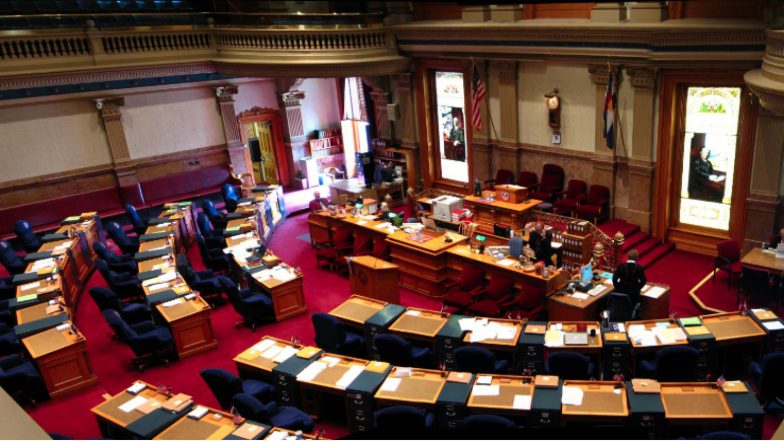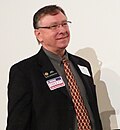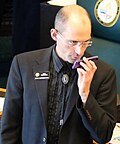Summary
The Colorado Senate is comprised of 35 Senators who are elected to four-year terms. Each Senator is limited to serving two consecutive terms. The President presides over the Senate during the legislative session, after being chosen by the majority caucus and subsequently elected to that office by a majority vote of all the members of the Senate. Legislative session begins no later than the second Wednesday in January and lasts up to 120 calendar days.
OnAir Post: Colorado Senate
About
Source: Wikipedia page
Contents
The Colorado State Senate is the upper house of the Colorado General Assembly, the state legislature of the US state of Colorado. It is composed of 35 members elected from single-member districts, with each district having a population of about 123,000 as of the 2000 census. Senators are elected to four-year terms, and are limited to two consecutive terms in office. Senators who are term-limited become eligible to run again after a one-term (four year) respite.
The Colorado Senate convenes at the State Capitol in Denver.
History
The first meeting of the Colorado General Assembly took place from November 1, 1876, through March 20, 1877.[2] Lafayette Head was the first state senate president.[2]
In 1885, the Colorado Senate appointed its first chaplain, Methodist circuit riding missionary, “Father” John Lewis Dyer.[3]
The lieutenant governor served as Senate President until 1974 when Article V, Section 10 of the state constitution was amended, granting the Colorado Senate the right to elect one of its own members as president.[2] Fred Anderson was the first state senate president elected after the amendment.[2] Ruth Stockton was the first woman to become Senate’s president pro tempore, serving from 1979 to 1980.[4][5]
Terms and qualifications
The Colorado Senate has 35 members elected to staggered four-year terms. Half the chamber is elected in the same year as gubernatorial elections, with the other half elected in the same year as presidential elections.
State senators are term-limited to two consecutive terms, equivalent to eight years. Term-limited former members can run again after a four-year break. Vacancies in legislative offices are generally filled by political party vacancy committees, rather than special elections. Vacancy appointees who fill the first half of a state senator’s term must stand for election at the next even year November election for the remainder of the state senate term for the seat to which the state senator was appointed.
Procedure and powers
With the notable exceptions listed below, the Colorado Senate operates in a manner quite similar to the United States Senate.[6]
Regular sessions are held annually and begin no later than the second Wednesday in January. Regular sessions last no more than 120 days. Special sessions may be called at any time by the governor of Colorado or upon written request of two-thirds of the members of each house, but are infrequent. Some committees of the General Assembly work between sessions and have limited power to take action without General Assembly approval between legislative sessions.
Joint procedural rules of the two chambers require most legislation to be introduced very early in the legislative session each year, and to meet strict deadlines for completion of each step of the legislative process. Joint procedural rules also limit each legislator to introducing five bills per year, subject to certain exceptions for non-binding resolutions, uniform acts, interim committee bills and appropriations bills. Most members of the General Assembly decide which bills they will introduce during the legislative session (or most of them) prior to its commencement, limiting the ability of members to introduce new bills at constituent request once the legislative session has begun.
Most bills adopted by the General Assembly include a “safety clause” (i.e. a legislative declaration that the bill concerns an urgent matter) and take effect on July 1 following the legislative session unless otherwise provided. Some bills are enacted without a “safety clause” which makes it possible to petition to subject those bills to a referendum before they take effect, and have an effective date in August following the legislative session unless otherwise provided.[6]
Colorado’s legislature does not have an analog to the filibuster in the United States Senate requiring a supermajority for approval of any matter. The state lieutenant governor does not have the power to preside or break tie votes in either house of the General Assembly.[2] New executive branch rules are reviewed annually by the legislature and the legislature routinely invalidates some of them each year.
The General Assembly does not have a role in the appointment or retention of state judges, although it must authorize the creation of each judgeship.
Many state agencies and programs are subject to “sunset review” and are automatically abolished if the General Assembly does not reauthorize them.
The state budget process
The governor submits a proposed budget to the Joint Budget Committee each year in advance of the year’s legislative session. Colorado’s fiscal year is from July 1 to June 30.
Bills introduced in the General Assembly are evaluated by the non-partisan state legislative services body for their fiscal impact and must be provided for in appropriations legislation if there is a fiscal impact.
A state budget, called the “LONG Bill” (Legislation on Operations and Normal Governance) is prepared each year by the Joint Budget Committee of the General Assembly. The House and the Senate alternate the job of introducing the long bill and making a first committee review of it. Colorado’s state legislature is required to obtain voter approval in order to incur significant debt, to raise taxes, or to increase state constitutional spending limitations. It is also required to comply with a state constitutional spending mandate for K-12 education. The governor has line item veto power over appropriations.
Current makeup
Based on the 2010 census, each state senator represents 143,691 constituents. The 2024 Colorado Elections resulted in the Democratic Party maintaining a majority of seats in the senate. Democrats currently hold a majority in the Senate in the 75th General Assembly: 23 Democrats and 12 Republicans.[7]
At the 2024 elections 18 senate seats came up for re-election. As a result, the composition of the State Senate at the beginning of the 75th General Assembly is 23 Democrats and 12 Republicans.[8]
With the Democratic majority in the current 75th General Assembly, James Coleman serves as President of the Senate and Robert Rodriguez serves as the Majority Leader.
Composition
| ↓ | ||
| 23 | 12 | |
| Democratic | Republican | |
| Affiliation | Party (Shading indicates majority caucus) | Total | |||
|---|---|---|---|---|---|
| Democratic | Ind | Republican | Vacant | ||
| 70th General Assembly | 17 | 0 | 18 | 35 | 0 |
| Beginning of 71st Assembly | 17 | 0 | 18 | 35 | 0 |
| December 29, 2017[a] | 16 | 1 | |||
| 72nd General Assembly | 19 | 0 | 16 | 35 | 0 |
| Beginning of 73rd Assembly | 20 | 0 | 15 | 35 | 0 |
| August 22, 2022[b] | 21 | 0 | 14 | ||
| 74th General Assembly | 23 | 0 | 12 | 35 | 0 |
| Beginning of 75th Assembly | 23 | 0 | 12 | 35 | 0 |
| November 26, 2025[9] | 22 | 34 | 1 | ||
| Latest voting share | 64.7% | 35.3% | |||
Leadership
| Position | Senator | Party | District |
|---|---|---|---|
| President | James Coleman | Democratic | 33 |
| President pro Tempore | Dafna Michaelson Jenet | Democratic | 21 |
| Majority Leader | Robert Rodriguez | Democratic | 32 |
| Assistant Majority Leader | Lisa Cutter | Democratic | 20 |
| Majority Whip | Nick Hinrichsen | Democratic | 3 |
| Majority Caucus Chair | Dylan Roberts | Democratic | 8 |
| Minority Leader | Cleave Simpson | Republican | 6 |
| Assistant Minority Leader | Lisa Frizell | Republican | 2 |
| Minority Caucus Chair | Byron Pelton | Republican | 1 |
| Minority Whip | Janice Rich | Republican | 7 |
Members of the Colorado Senate
- *Senator was originally appointed
- #Senator is ineligible for re-election due to term limits
Past composition of the Senate
See also
- Outline of Colorado
- Index of Colorado-related articles
- State of Colorado
- United States of America
References
- ^ Cheri Jahn left the Democratic Party and registered as an Independent.
- ^ Kevin Priola switched from the Republican Party to the Democratic Party.
- ^ “Salaries for Legislators, Statewide Elected Officials, and County Officers”. Colorado General Assembly. Retrieved July 7, 2023.
- ^ a b c d e Presidents and Speakers of the Colorado General Assembly: A Biographical Portrait from 1876 Archived January 15, 2015, at the Wayback Machine, Colorado.gov, 2013 Revised Edition. (accessed May 27, 2013)
- ^ “Verifiable Oddities in Colorado’s History-The Snowshoe Chaplain of the State Senate”. legisource.net. February 23, 2012. Retrieved January 19, 2014.
- ^ “Colorado legislators past and present”. Colorado State Legislature. Retrieved April 18, 2018.
- ^ “Ruth Stockton”. Colorado Women’s Hall of Fame. Retrieved April 16, 2018.
- ^ a b How a Bill Becomes Colorado Law Archived October 10, 2015, at the Wayback Machine, Office of Legislative Legal Services, October 2001 (accessed May 27, 2013)
- ^ “Official Results”. Colorado Secretary of State. Retrieved February 21, 2025.
- ^ “Colorado Election Results”. The New York Times. November 8, 2022. ISSN 0362-4331. Retrieved February 3, 2023.
- ^ Democrat Faith Winter (District 25) died. [1]
External links
39°44′21″N 104°59′05″W / 39.7392°N 104.9848°W




































